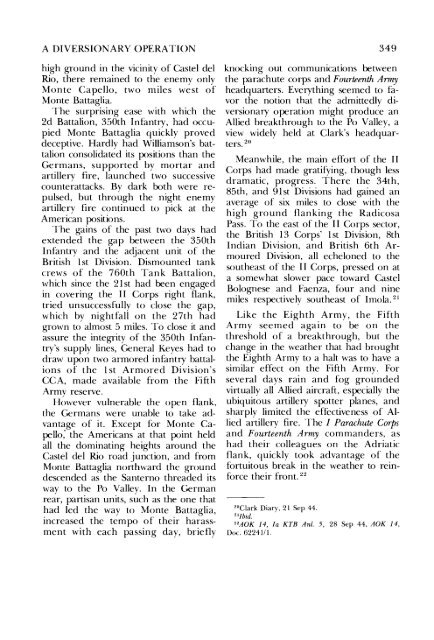Cassino to the Alps - US Army Center Of Military History
Cassino to the Alps - US Army Center Of Military History
Cassino to the Alps - US Army Center Of Military History
You also want an ePaper? Increase the reach of your titles
YUMPU automatically turns print PDFs into web optimized ePapers that Google loves.
A DIVERSIONARY OPERATION<br />
high ground in <strong>the</strong> vicinity of Castel del<br />
Rio, <strong>the</strong>re remained <strong>to</strong> <strong>the</strong> enemy only<br />
Monte Capello, two miles west of<br />
Monte Battaglia.<br />
The surprising ease with which <strong>the</strong><br />
2d Battalion, 350th Infantry, had occupied<br />
Monte Battaglia quickly proved<br />
deceptive. Hardly had Williamson's battalion<br />
consolidated its positions than <strong>the</strong><br />
Germans, supported by mortar and<br />
artillery fire, launched two successive<br />
counterattacks. By dark both were repulsed,<br />
but through <strong>the</strong> night enemy<br />
artillery fire continued <strong>to</strong> pick at <strong>the</strong><br />
American positions.<br />
The gains of <strong>the</strong> past two days had<br />
extended <strong>the</strong> gap between <strong>the</strong> 350th<br />
Infantry and <strong>the</strong> adjacent unit of <strong>the</strong><br />
British 1 st Division. Dismounted tank<br />
crews of <strong>the</strong> 760th Tank Battalion,<br />
which since <strong>the</strong> 21st had been engaged<br />
in covering <strong>the</strong> II Corps right flank,<br />
tried unsuccessfully <strong>to</strong> close <strong>the</strong> gap,<br />
which by nightfall on <strong>the</strong> 27th had<br />
grown <strong>to</strong> almost 5 miles. To close it and<br />
assure <strong>the</strong> integrity of <strong>the</strong> 350th Infantry's<br />
supply lines, General Keyes had <strong>to</strong><br />
draw upon two armored infantry battalions<br />
of <strong>the</strong> 1 st Armored Division's<br />
CCA, made available from <strong>the</strong> Fifth<br />
<strong>Army</strong> reserve.<br />
However vulnerable <strong>the</strong> open flank,<br />
<strong>the</strong> Germans were unable <strong>to</strong> take advantage<br />
of it. Except for Monte Capello;<br />
<strong>the</strong> Americans at that point held<br />
all <strong>the</strong> dominating heights around <strong>the</strong><br />
Castel del Rio road junction, and from<br />
Monte Battaglia northward <strong>the</strong> ground<br />
descended as <strong>the</strong> Santerno threaded its<br />
way <strong>to</strong> <strong>the</strong> Po Valley. In <strong>the</strong> German<br />
rear, partisan units, such as <strong>the</strong> one that<br />
had led <strong>the</strong> way <strong>to</strong> Monte Battaglia,<br />
increased <strong>the</strong> tempo of <strong>the</strong>ir harassment<br />
with each passing day, briefly<br />
349<br />
knocking out communications between<br />
<strong>the</strong> parachute corps and Fourteenth <strong>Army</strong><br />
headquarters. Everything seemed <strong>to</strong> favor<br />
<strong>the</strong> notion that <strong>the</strong> admittedly diversionary<br />
operation might produce an<br />
Allied breakthrough <strong>to</strong> <strong>the</strong> Po Valley, a<br />
view widely held at Clark's headquarters.<br />
20<br />
Meanwhile, <strong>the</strong> main effQrt of <strong>the</strong> II<br />
Corps had made gratifying, though less<br />
dramatic, progress. There <strong>the</strong> 34th,<br />
85th, and 91st Divisions had gained an<br />
average of six miles <strong>to</strong> close with <strong>the</strong><br />
high ground flanking <strong>the</strong> Radicosa<br />
Pass. To <strong>the</strong> east of <strong>the</strong> II Corps sec<strong>to</strong>r,<br />
<strong>the</strong> British 13 Corps' 1 st Division, 8th<br />
Indian Division, and British 6th Armoured<br />
Division, all echeloned <strong>to</strong> <strong>the</strong><br />
sou<strong>the</strong>ast of <strong>the</strong> I I Corps, pressed on at<br />
a somewhat slower pace <strong>to</strong>ward Castel<br />
Bolognese and Faenza, four and nine<br />
miles respectively sou<strong>the</strong>ast of Imola. 21<br />
Like <strong>the</strong> Eighth <strong>Army</strong>, <strong>the</strong> Fifth<br />
<strong>Army</strong> seemed again <strong>to</strong> be on <strong>the</strong><br />
threshold of a breakthrough, but <strong>the</strong><br />
change in <strong>the</strong> wea<strong>the</strong>r that had brought<br />
<strong>the</strong> Eighth <strong>Army</strong> <strong>to</strong> a halt was <strong>to</strong> have a<br />
similar effect on <strong>the</strong> Fifth <strong>Army</strong>. For<br />
several days rain and fog grounded<br />
virtually all Allied aircraft, especially <strong>the</strong><br />
ubiqui<strong>to</strong>us artillery spotter planes, and<br />
sharply limited <strong>the</strong> effectiveness of Allied<br />
artillery fire. The I Parachute Corps<br />
and Fourteenth <strong>Army</strong> commanders, as<br />
had <strong>the</strong>ir colleagues on <strong>the</strong> Adriatic<br />
flank, quickly <strong>to</strong>ok advantage of <strong>the</strong><br />
fortui<strong>to</strong>us break in <strong>the</strong> wea<strong>the</strong>r <strong>to</strong> reinforce<br />
<strong>the</strong>ir front. 22<br />
2°Clark Diary, 21 Sep 44.<br />
"Ibid.<br />
22AOK 14, Ia KTB AnI. 5, 28 Sep 44, AOK 14,<br />
Doc. 622411 I.
















